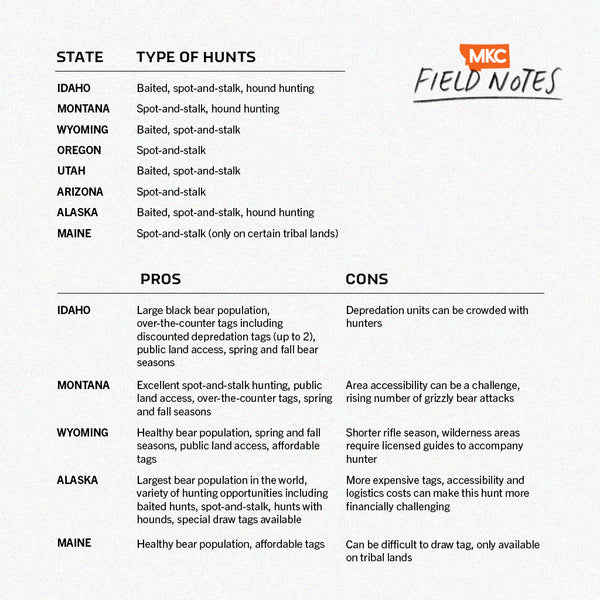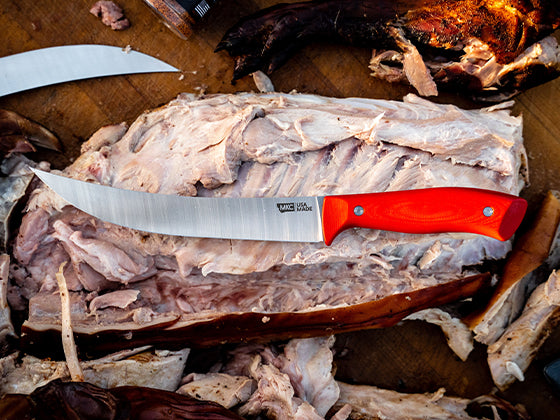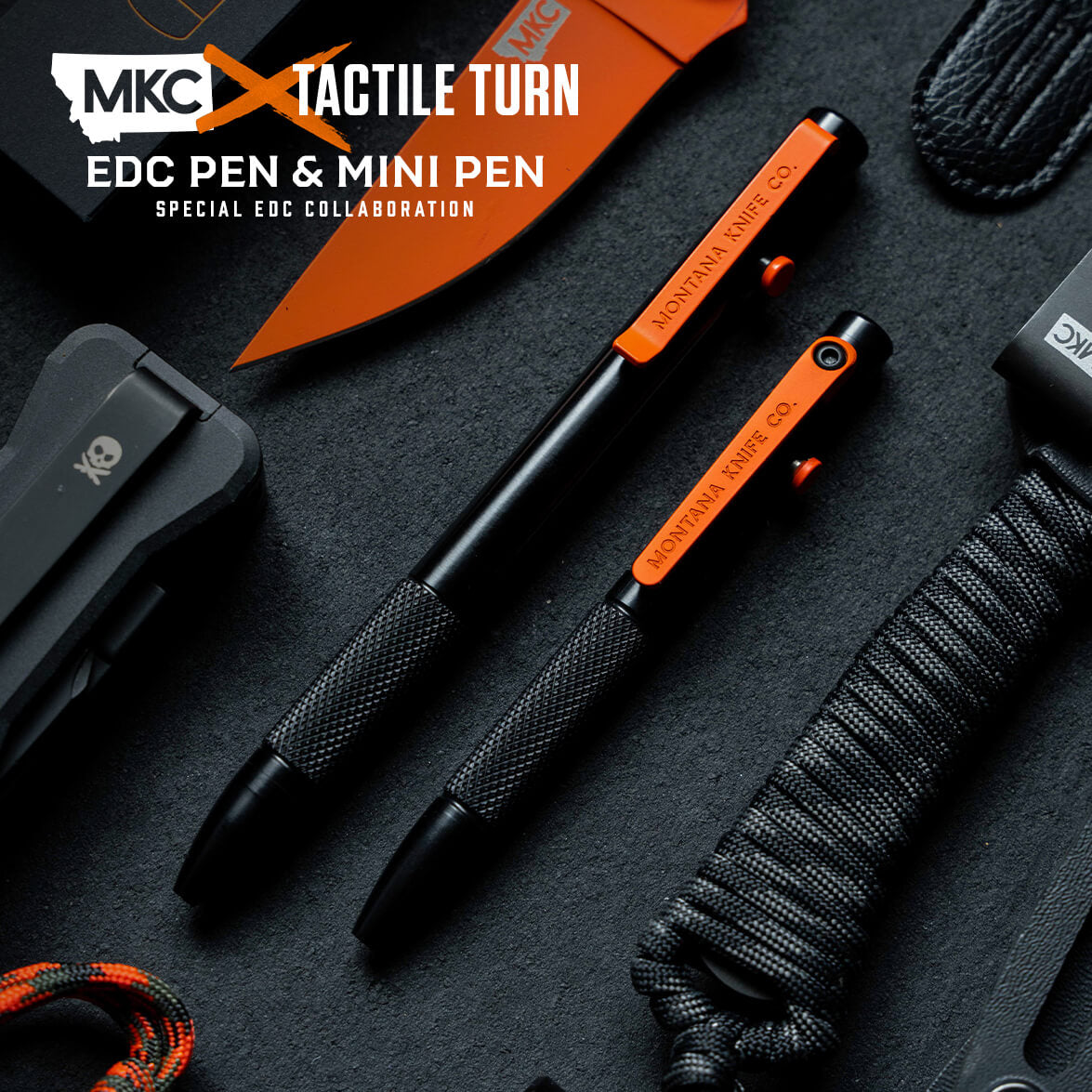Bears have always fascinated me. When I was a kid, I always looked for them during family trips to the Appalachian Mountains. However, it wasn’t until I moved out West in 2016 that I finally participated in spring bear hunts.
This growing fascination wasn’t an overnight process. I didn’t tag my first bear until 2020. He was 11 years old (discovered via tooth aging), and his skull measured 20 and 3/16 inches.
If I wasn’t obsessed with bears before, I definitely was after that takedown.
I’ve dedicated a lot of time to educating others on all things spring bear hunting. I hunt, process, and eat them myself. I’m a lifetime member of the American Bear Foundation, I started a media company about bear hunting, and I even write blog posts about Montana bear hunting (like this one).
Let me teach you what I know.
Why Spring Bear Hunting?
I love springtime. After a long, cold, sleepy winter, I can’t stop thinking about the mountains and how they slowly wake up during spring. The barren trees bloom, temperatures rise, and the snow-capped mountains reveal their rocky faces.
Most importantly, the animals start to move around.
Spring bear hunting is a great way to participate in predator management. Deer and elk reproduce in the fall and winter, and areas with high spring bear populations can put undue stress on those species.
It’s not uncommon for a boar to chase a sow and cannibalize her cubs so she can go back into heat and re-breed. Targeting mature boars in the spring allows those cubs to grow to adulthood, benefiting the bear population.
Spring bear hunting is a great way to familiarize yourself with local wildlife patterns. It’s also an ideal time to hunt for antler sheds, mushrooms, and turkeys, since turkey and bear seasons usually overlap.
Prepare for Spring Bear Hunting: Tips for New Hunters
Spring bear hunting in the mountains is beautiful, but the weather can be temperamental. I’ve experienced days that start in the sunny 70s and end in the snow. Be prepared for adverse weather. I keep rain gear, a puffy jacket, and gloves in my pack.
I always have some kind of fire starter and multiple lighters on hand, too, right alongside my medical kit. I also recommend carrying a GPS locator, such as a Garmin inReach, so people can find you in an emergency.
I always let someone know where I’m headed, when I’m headed there, and when I plan to leave. That way, if I don’t turn up where I’m supposed to be, they know to call for help.
If you’re black bear hunting in a state with mountainous terrain, physically prepare for your hunt. Elevation differences can be brutal, and bears tend to hang out in steep areas. Being in good physical shape helps a lot, especially on a Montana bear hunt.
The right footwear is also a tremendous help. I recommend hunting boots with good ankle support. A rolled ankle is the last thing you want on a long-distance mountain trek. You may want to bring trekking poles for extra stability, too.
Pre-scouting the area where you want to hunt can save time and energy. Modern technology can give us “eyes on the ground” without being there in person, thanks to GPS maps like onX Hunt. Reading blog posts (like this one) and watching YouTube videos of spring bear hunts helps as well.
If you’d like a more comprehensive crash course, look into Treeline Academy, run by my friend Mark Livesay. His spring bear hunting e-scouting courses are in-depth and helpful for hunters of all skill levels.
Black Bear Hunting Tips: Examining Bears In-Depth
The goal of spring bear hunting is to catch bears as they emerge from hibernation. This is often easier said than done, as different bear species emerge at different times.
Even bears within the same species emerge at different times, depending on latitude and food scarcity. For example, a bear with less to eat before hibernation may emerge sooner than one who ate well.
Black bears typically hibernate for 90–150 days, emerging between March and April. They wake up hungry and motivated to replenish their lost fat stores, and they hunt for easy food sources that don’t require much energy.
Mature boars exit hibernation first. They emerge early to prepare for the spring rut. Early hunting and foraging allow them to be in top form when searching for sows. Cubless sows emerge next, while sows with cubs exit hibernation last.
While the sows concern themselves with food upon emerging, the boars have two motivators: food and rut. Use this knowledge to your advantage as you work to hunt them down.
How Weather Affects Spring Emergence
Weather also affects how bears behave in the spring. An early, warm spring jump-starts the emergence, bringing the bears out earlier than normal. Similarly, a long winter keeps them in their dens longer.
While it’s good that the bears themselves are flexible, this may spell trouble for your carefully planned springtime bear hunts. It’s not always possible to change travel plans, but you can change the way you hunt.
The first step in accounting for weather is researching trends in your hunting area. As your travel date approaches, monitor current weather trends and do what you can to predict conditions during your trip. Be prepared for anything.
If the winter has been long and cold, you may run into fewer bears, but they may be hungrier and more motivated by food. If spring comes early, watch for sows with cubs, and consider gearing your hunting tactics toward boars in rut.
Visibility plays a role in your spring bear hunts, too. If you’re hunting during an early, warm spring, the environment may already be green and teeming with plant life. This makes it difficult to see and hear your quarry and pinpoint their favorite food sources.
While a late winter sometimes makes finding the bears’ food sources easier, you may end up dealing with scarcity. Colder temperatures mean food sources may still be emerging, and the bears may be hard to find. Fewer bears mean lower chances of an encounter, though fewer food sources also mean higher chances for a meeting if you can find a good spot.
States for Spring Bear Hunts
Below, we’ve listed the eight U.S. states that offer spring bear hunts and the pros and cons for nonresidents to consider before traveling for spring bear hunting. Time frames and regulations vary from state to state, so check with local wildlife agencies for up-to-date information.

Black Bear Hunting Tips, Safety, and Tactics
Black bears run away when confronted, but they can still dish out life-threatening injuries. This is especially likely if you meet a sow with cubs.
Staying Safe
While bear hunting expeditions in Wyoming, Idaho, and Montana target black bears, those may not be the only bears you encounter.
Grizzly bear populations are on the rise, and currently, they don’t have a regulated hunting season. This means these naturally aggressive critters are less averse to people. Over the last few years, the number of grizzly attacks has skyrocketed.
When I hunt in grizzly country, I take careful stock of my surroundings, especially if I’m using a predator call to attract a bear. I carry a readily accessible pistol alongside my rifle, and I recommend you do the same. Some people opt for bear spray, but I don’t consider spray as reliable as a sidearm.
More often than not, attacks happen because a hunter stumbles into a bear’s territory. Bears are tough creatures, and even with good shot placement and an appropriate caliber bullet, they can continue to charge. (I’ve experienced this. It’s terrifying.)
Never follow an injured bear into thick cover. An injured bear will run into thick brush where visibility is low. Give them time to expire before following them in, and have your firearm drawn and ready. It may be best to wait for the morning before pursuing your target, especially if it’s already dark.
Bears are food-driven creatures. They may follow you into your camp or even visit the kill site of an animal you just harvested. Stashing food away from your camp or in a tree helps you avoid trouble.
Finding Bears
If you find their food, you find the bears. Bears’ food sources change throughout the year. In spring, they’re attracted to green, fresh grass close to the snow line.
Torn stumps and flipped rocks indicate that a nearby bear is searching for insects, grubs, and larvae. Prey animal populations — especially deer fawns and elk calves — often tempt bears close, too.
I have the best luck finding bears in steep, rocky terrain. They run hot because of their thick fat and fur, so they like to hang out around water or in the shade to stay cool. I’ve found them in ponds, wallows, and old timber burns for the same reasons.
Spot-and-stalk hunting is my favorite black bear hunting method. If you want to try it, invest in a good spotting scope or pair of binoculars. Bears are most active in the mornings and evenings, so glassing during these times should yield the best results.
Glassing also allows you to play the wind correctly, as bears have incredibly acute senses of smell. As a nice bonus, it keeps you from spreading your scent all over the mountain.
I’ve found that spring bears really like old logging roads. I prefer the gated ones that prevent vehicle access. Bears travel them for two reasons: they’re quiet, and they’re often bordered by rich, green grass shoots. They like taking the path of least resistance.
I love hunting with a predator call, but this method isn’t without risk. Good visibility and preparedness are key when you’re trying to bring a hungry and potentially angry bear closer!
Final Thoughts on Spring Bear Hunting
Spring bear hunting is challenging, especially if you’re new to it. Preparation and knowledge go a long way.
Just observing these creatures is rewarding, even if you fail to take one down. I’m lucky to get out there, learn more about them, and traverse our incredible public lands. It’s all about the experience and what you take from it.
The only way to be successful is to get out there and try. I wish all of you spring bear hunters — seasoned and new — the best of luck this upcoming season.
by Brett Benton, MKC Customer Experience Manager, and Avid Bear Hunter.







































